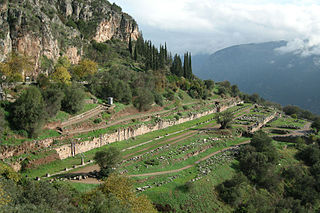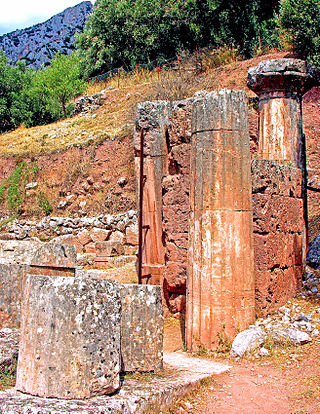The palaestra
On the lower terrace was situated the palaestra, comprising a square central court of the "impluvium" type, surrounded by porticoes divided in rooms. There were two entrances from the southeast and from the north. The inscriptions inform us on the usage of these rooms as pool room, changing rooms, fighting room and platform. To the west of the palaestra there is still visible today a round pool of a 10-metre-long (33 ft) diameter and a depth of 1.80 metres (5.9 ft). Castalia provided water to this basin which, in its turn, distributed water to ten stone bathing basins. In the Roman period a bath with hot water was built also close to the Gymnasium, thus offering an extra luxury to the athletes.
The Gymnasium was first built at around 330 B.C., whereas additions and restoration works took place in various phases throughout its history. Many of the travelers who visited Delphi throughout the Ottoman period used to stay at the monastery of Panagia and carved their names on some fallen columns of the Gymnasium which lay in situ ; these signatures and marks, notably the one by Lord Byron, can be seen today on the restored columns.

Delphi, in legend previously called Pytho (Πυθώ), was an ancient sacred precinct and the seat of Pythia, the major oracle who was consulted about important decisions throughout the ancient classical world. The ancient Greeks considered the centre of the world to be in Delphi, marked by the stone monument known as the omphalos (navel).

A palaestra was any site of an ancient Greek wrestling school. Events requiring little space, such as boxing and wrestling, took place there. Palaestrae functioned both independently and as a part of public gymnasia; a palaestra could exist without a gymnasium, but no gymnasium existed without a palaestra.

The palaestra at Olympia is the ground or grounds in ancient Olympia where πάλη, Doric πάλα, "wrestling," was taught and performed for training purposes; i.e., "wrestling-school." Two other martial arts were taught there: Greek πυγμή (pygme), Latin pugnus, "fist, boxing," and Greek παγκράτιον, Latin pancration or pancratium, "any method," which was free-style, or hand-to-hand, including grappling, kicking, punching, or any unarmed method whatever, no holds barred. The latter was sometimes deadly, or disfiguring, which indicates that the arts were ephebic, or "soldier" training for prospective citizens of the city-state sponsoring the school, such as Elis, but here combined with prospective candidacy for contention in the games. Be that as it may, none of the games were conducted without rules, umpires, and judges, who did not hesitate to stop contests, fine contenders with in some cases amounts prohibiting future participation, or bar flagrant violators.

The palaestra at Delphi is part of a gymnasium at the sanctuary. It is the oldest existing gymnasium from the Greek world, dating to the second half of the fourth century B.C. It was built on two terraces, with the palaestra and baths on the lower terrace. The frequent earthquakes and landslides at Delphi have damaged the palaestra the most seriously of all of the gymnasium areas.

The Siphnian Treasury was a building at the Ancient Greek cult centre of Delphi, erected to host the offerings of the polis, or city-state, of Siphnos. It was one of a number of treasuries lining the "Sacred Way", the processional route through the Sanctuary of Apollo, erected to win the favor of the gods and increase the prestige of the donor polis. It was one of the earlier surviving buildings of this type, and its date remains a matter for debate, with the most plausible date being around 525 BC. Until recently it was often confused or conflated with the neighbouring Cnidian Treasury, a similar but less elaborate building, as the remains of the two had become mixed together and earlier theoretical reconstructions used parts of both.

The Stoa of the Athenians is an ancient portico in the Delphic Sanctuary, Greece, located south of the Temple of Apollo. The southern side of the polygonal wall of the platform forms the north wall of the stoa. It was constructed c. 478 BC-470 BC during the early Classical period. The one-aisled stoa with Ionic colonnade opens toward the southeast. It was dedicated by the Athenians after the Persian Wars.
The Lesche of the Knidians was a lesche, i.e. a club or meeting place, at the sanctuary of Apollo in Delphi. Today, it has been mostly destroyed; the only surviving parts are some architectural relics. It hosted two famous paintings by the famous painter Polygnotus the Thasian, namely the Capture of Troy and the Nekyia. It was built in the second quarter of the 5th century BC. Apparently it was a rectangular building, bearing a clerestory along its western side, and perhaps with a tripartite interior arrangement. In the 4th century, a wall was added along its southern side for placing ex votos.
The Ottomans finalized their domination over Phocis and Delphi in ca. 1410. Delphi itself remained almost uninhabited for centuries. It seems that one of the first buildings of the early modern era was the monastery of the Dormition of Mary or of Panagia built above the ancient gymnasium. It must have been towards the end of the 15th or in the 16th century that a settlement started forming there, which eventually ended up forming the village of Kastri.

The Temple of Athena Pronaia was a temple at the ancient site of Delphi, in the Sanctuary of Athena Pronaia, a group of buildings comprising temples and treasuries as well as the famous Tholos of Delphi. There were in fact three successive temples built at the site. The earlier temples (38°28′49″N22°30′30″E), referred to as A and B, were built in the 7th and 6th centuries BC respectively and were made of porous stone; a third temple (38°28′49″N22°30′28″E) was built of limestone in the 4th century BC, although it is not certain that it actually was dedicated to Athena this time.

The tenth book of the work Description of Greece by the traveler Pausanias is dedicated to Phocis; its larger part constitutes a description of the sanctuaries and buildings of Delphi. His work constituted a precious aid to travelers and archaeologists who attempted to identify the monuments revealed by the excavations, although in some cases their identifications were not enough.

The Stadium of Delphi lies on the highest spot of the Archaeological Site of Delphi. It overlooks the sanctuary of Apollo and has a view to the Delphic landscape. It was built either within the second half of the 4th century B.C. or even after the Galatian attacks. Its measured 178 meters in length and knew several refurbishment phases. The Stadium of Delphi is the best preserved ancient stadium in Greece.

The stele of Prusias is one of the ex votos at the sanctuary of Apollo in Delphi, constructed in honour of king Prusias II of Bithynia.

The Portico of the Aetolians, known also as the Western Portico, is one of the largest buildings of Delphi, situated outside of the sacred precinct of the sanctuary of Apollo.
The Treasury of Cyrene was a building in the sanctuary of Apollo in Delphi. The treasury was possibly built as a token of gratitude for a large endowment of wheat offered to Delphi's inhabitants during a lean period.

The Treasury of the Sicyonians is one of the buildings within the sanctuary of Apollo in Delphi. It has a long and complicated history. The treasury itself replaced two former buildings, namely the tholos and the monopteros, built by the same city at an earlier stage within the 6th century. The earlier buildings were related to the Orthagorids of Sicyon and particularly to the victories of the tyrant Cleisthenes of Sicyon in the course of the First Sacred War and their replacement probably marks the change in tide in Sicyonian politics.
Archaeological investigation in Delphi started in the second half of the 19th century, but it was not until 1892 when a systematic excavation began under the direction of Théophile Homolle and the French Archaeological School of Athens. The "Great Excavation" lasted 10 years and was concluded by the creation of the first museum on-site. In the years to follow, the site never ceased to be excavated and investigated. Several of the monuments were restored and new interpretations continue to see the light in the academic field.
Several Hellenistic kings dedicated monuments in the sanctuary of Apollo in Delphi, in an effort to emphasize their prestige. Among those kings were the Attalids of Pergamon, who occupied a prominent position at the highest point of the Sacred Way, close to the temple of Apollo where they erected their ex votos.

Behind the column with the Dancers of Delphi was situated the Athenian Treasury, where was located the famous ex voto of Daochos, a long marble base where stood nine statues, eight of which represented members of Daochos' family and one a god, probably Apollo. Daochos II, son of Agias, a politician from Pharsalus and supporter of Macedonia, was a hieromnemon at the delphic sanctuary from 336 to 332 B.C. He dedicated the ex voto as a sign of honour to his prominent family.

The Treasury of the Thebans at Delphi was built in the Doric order and made entirely out of local limestone from the quarries of St. Elias close to the town of Chrisso. It was situated a few meters below the first turn of the Sacred Way, the processional route in the sanctuary of Apollo. It had been dedicated by the Thebans for their victory against the Lacedaemonians at Leuctra.

Fernand Henri Fabien Courby was a French archaeologist and Hellenist, a specialist of ancient Greece, a member of the French School at Athens, and professor at the Faculté des lettres of the University of Lyon.















